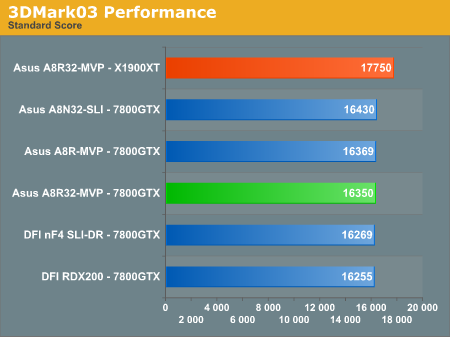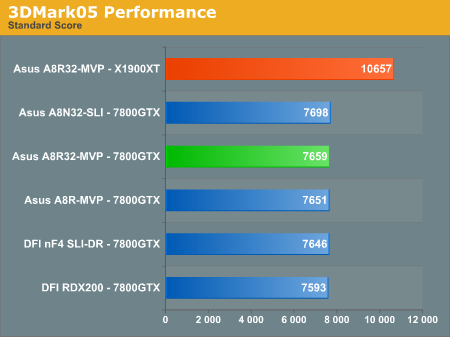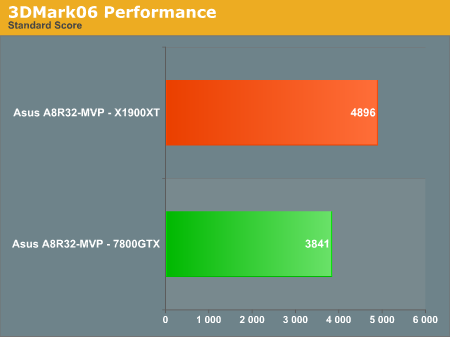Asus A8R32-MVP Deluxe: First ATI RD580
by Wesley Fink on March 1, 2006 9:00 AM EST- Posted in
- Motherboards
Graphics Performance and Encoding
The 3DMark benchmarks, published by FutureMark, are probably the most widely quoted gaming performance benchmarks available. While the benchmarks are based on game sequences written by FutureMark to reveal subtle differences in gaming performance, they still have to be considered synthetic benchmarks. They are useful for broad Graphics comparisons, but they are no substitute for benchmarks with real gaming engines that are currently being played.
3DMark06 was recently introduced and you can find more in-depth information about this new 3DMark at in the AnandTech article Futuremark's Latest Attempt: 3DMark06 Tested.
The 3DMark benchmarks, published by FutureMark, are probably the most widely quoted gaming performance benchmarks available. While the benchmarks are based on game sequences written by FutureMark to reveal subtle differences in gaming performance, they still have to be considered synthetic benchmarks. They are useful for broad Graphics comparisons, but they are no substitute for benchmarks with real gaming engines that are currently being played.
3DMark06 was recently introduced and you can find more in-depth information about this new 3DMark at in the AnandTech article Futuremark's Latest Attempt: 3DMark06 Tested.














65 Comments
View All Comments
superkdogg - Wednesday, March 1, 2006 - link
If you had been working for half the time you have been whining on every forum you can find, you could have bought two SLI-Experts or whatever motherboard you think has no problems.Dude, get over it. The A8R was not exactly as reviewed here. Is that disappointing? Yep. Unfair? Maybe. Fact is, anybody who bought it for the "serious overclocking" that you're referencing would do a vMod and get on with it. I have two A8R's. One is dead because I was stupid and tried a vMod. My soldering needs work. I bought a second one on refurb for $75 because I realized that in the best case, that vMod might get me another 150 MHz. You know what else would get me 150 MHz? Dusting off a Pentium Pro in my basement. I could also get the 2% benefit that 1T timing would give me from chance, since most 'marks are + or - 2-3%.
I was burned by the same problem you were. I have learned to live with it and am currently happily running 300x9 with ram @ 2.5-4-4-9, 2T (166/200). That's not bad for standard blue heatspreader Patriot that runs about $80 per gig.
DigitalFreak - Wednesday, March 1, 2006 - link
Omid, is that you?yacoub - Sunday, February 19, 2006 - link
Should have run the 3DMark benches with the 7800GTX like all the other boards so at least we could see if the board itself (the object of review) offered any particular performance gain or loss. :[yacoub - Sunday, February 19, 2006 - link
oic now, thanks. :)green bars. tricksy hobbitses!
Missing Ghost - Sunday, February 19, 2006 - link
I am unhappy with the pictures of the board included in this review. I can't see anything on them because they are too dark. I couldn't even tell if they were a firewire port on the back.Wesley Fink - Wednesday, March 1, 2006 - link
The pictures are not overly dark on several monitors we tried in reading the review. I'm sorry I don't have advice in that area.As stated in the review, both Firewire ports are on an accesory bracket included with the motherboard. The bracket will fit in an empty slot or can be routed to case firewire ports.
Googer - Sunday, February 19, 2006 - link
What Phase Power is this motherboard using? 2,3,4,8,24?Beenthere - Sunday, February 19, 2006 - link
Any properly designed 3-phase or greater CPU vcore circuit that complies with AMD's VRM64/T specs will work just fine. If however a mfg. delivers a poor circuit design or uses inferior MOSFETS, caps, etc., then you experience Vcore instability which causes all kinds of operational Hell. More phases just lowers the ripple and spreads the load across more MOSFETS.Beenthere - Sunday, February 19, 2006 - link
BTW, if you check the A8R-MVP, the A8N series and the Asus P5GL-MX you'll see that all of these mobos have been confirmed to have vcore instability problems when tested at the mobo with a DVM or scope. Asus seems to have some significant mobo engineering issues they can't resolve... and that are not present on other brands of mobos using the same chipsets.Ecmaster76 - Sunday, February 19, 2006 - link
Do you work for DFI or Abit or something? This is the third site where I have ran into you flaming Asus constantly!(where did I put that troll repellant)
Seriously, link some proof of said Vcore instability. Show me scope printouts of the Vcore lines (and the 12v rails that were used to drive it)